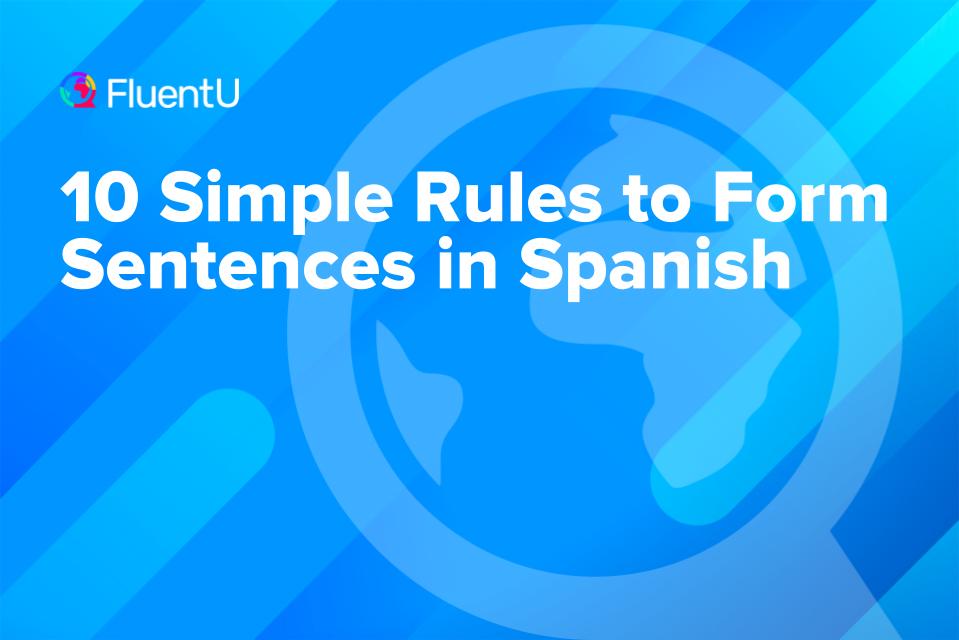Contents
- Why Learn the Basics of Spanish Sentences?
- 10 Essential Rules for Crafting Simple Spanish Sentences
- 1. Every Spanish sentence needs a subject and a verb (at the minimum).
- 2. Use the right gender.
- 3. Use the right article.
- 4. Adjectives come after nouns in Spanish sentences.
- 5. Connect subjects with verbs/other parts of speech with “to be” verbs.
- 6. Adverbs function in Spanish like they do in English.
- 7. To make a Spanish sentence negative, add “no” before the verb.
- 8. Bring them all together with conjunctions.
- 9. Master your phrasal verbs.
- 10. There are three ways to make questions in Spanish.
- How to Practice Making Spanish Sentences
- And One More Thing…
10 Simple Rules to Form Sentences in Spanish

Struggling to string the Spanish words you know into a coherent phrase?
The most likely explanation is you need to brush up on basic Spanish sentence construction.
And no, it’s not exactly the same as in English. But hey, if it were, learning a new language wouldn’t be so fun and unique.
So let’s figure out how to put those sentences together and start speaking Spanish.
Download: This blog post is available as a convenient and portable PDF that you can take anywhere. Click here to get a copy. (Download)
Why Learn the Basics of Spanish Sentences?
Once you get these simple rules down, you’ll be able to construct more complex sentences. Think of the language as a building (or Jenga stack, if you will). If you don’t construct the foundations properly, the whole thing will fall down. But once you have a solid foundation, you’re free to build whatever you like on top.
And that thing about Spanish and English not being the same. Is that really true? Well, Spanish is similar to English in some ways. Its structure is not so different that you’ll have to totally rethink the way you see life to get your head around it, but there are some differences.
As you’d imagine, it’s these differences that lead to most mistakes being made. So pay attention, because you’re about to learn the building blocks for your future Spanish-speaking life.
10 Essential Rules for Crafting Simple Spanish Sentences
1. Every Spanish sentence needs a subject and a verb (at the minimum).
To make a normal, affirmative sentence, you need a subject and a verb, at the very least. Of course, there are going to be variations on that, but we’ll get to those in a bit.
For a refresher:
- The subject is the “do-er.” It takes an active role in your sentence or is the key element or topic. A subject might be a person’s name, an animal or a machine, for example.
- A verb is an action word like comer (to eat), poder (to be able to), beber (to drink) and escuchar (to listen). You’ll also come across “being verbs” and “infinitive verbs,” but for simplicity’s sake, we’ll tackle those in later sections.
Subject + verb
Let’s say your subject is Juan (a common Spanish masculine name that corresponds to the English “John”) and your verb is escribir (to write). You can then make the simple sentence:
Juan escribe. (Juan writes.)
At this point, it’s worth noting that knowing how to conjugate Spanish verbs is a must. That means learning the rules and exceptions for applying tenses to each verb.
For example, John escribe , but I escribo . Knowing these conjugations can take time, so when you’re just starting out, try to focus on the present tense.
Subject + verb + object
Now, let’s add one more element into the mix: the object. In simple terms, the object is what’s being affected by the verb. For example, in our last sentence, you may be wondering “What is Juan writing?” The answer to that question is the object.
Again, let’s say Juan is writing a letter ( carta ), which would be the object as shown below:
Juan escribe una carta. (Juan writes a letter.)
Note the article una (a/an), which should agree with the number of the object (singular) and its gender (feminine). (The masculine form of una would be uno .) Both the number and gender will affect the verb and any adjectives you use. Don’t worry: I’ll walk you through these concepts in more detail later.
When a subject can be omitted
To make things even easier, it’s often possible to omit the subject once you know who or what is being talked about. So if you said Juan escribe, your next sentence could be Escribe bien (He writes well).
Since Juan is the subject in the first sentence, and the verb in the second sentence suggests that the subject is a he/she/it, it’s safe to assume that Juan is still the subject.
You could also use a pronoun to replace the subject by writing Él escribe (He writes). As long as the subject has already been mentioned, it’s fine to do this.
This doesn’t contradict the idea that Spanish sentences need a subject and a verb. In the last few examples, it’s possible to omit the subject because you already know what or who the subject is from the context. So technically, there’s still a subject in phrases like Escribe bien and Él escribe—it’s just that they’re implied instead of spelled out.
2. Use the right gender.
Using the right gender for nouns is key in Spanish, as it can change entire sentences. Imagine what could happen if you mix up words like pulpo (octopus) and pulpa (pulp).
While writing and developing your vocabulary lists, make sure to include the gender of the noun next to the word in parentheses. For example:
(una) casa — a house
As a general rule for gender, nouns that end in o are masculine and those that end in a are feminine, but there are exceptions. Mastering noun gender can be a bit tricky, but it really polishes your sentence skills.
As an aside, I find it odd that many teachers decide not to include noun gender until the intermediate level. There’s a school of thinking that says you shouldn’t focus on grammar from the get-go. Instead, you should focus on immersion and absorbing words in their natural context. And don’t get me wrong: that’s a valid approach too!
However, if you want to start communicating right away, memorizing a few simple building blocks gives you a decent breadth of expressions to use in speech and writing right away.
3. Use the right article.
Once you master your noun genders, placing articles will be a breeze.
Here’s a quick table of Spanish articles.
| Article | Type of Article | Masculine Singular | Masculine Plural | Feminine Singular | Feminine Plural |
|---|---|---|---|---|---|
| the | definite | el | los | la | las |
| a/an | indefinite | un | unos | una | unas |
These articles are used much more frequently than they are in English, so you’ll need to know where and when to place them.
Some tricky ones to watch out for are subjects like la gente (the people) or la familia (the family)—these subjects refer to many or multiple people but are considered singular subjects. Note that the article “la” in front of them is also singular. Any verbs connected to these subjects need to be conjugated as singular, third person.
Watch this video to see more examples of subjects and matching verbs or adjectives.
4. Adjectives come after nouns in Spanish sentences.
An adjective describes a subject or object. Some examples of adjectives are rojo / roja (red) and alto / alta (tall). You can see some more adjectives in action here.
This is where English speakers are likely to make mistakes. Imagine that Juan has green eyes and you want to say so in Spanish. You need to write that he has ojos verdes (literally: eyes green) and not verdes ojos.
Putting the adjective after the noun is one of the first rules Spanish learners have to grasp and its importance cannot be stressed enough.
This rule applies to other adjective and noun combinations. If Juan has long hair, you’d say he has pelo largo
(literally: hair long) and if it’s short, it would be pelo corto
(hair short).
Just to make things even more confusing, you also need to make your adjectives agree. So if the noun is plural, the adjective needs to be plural too. For example, since ojos (eyes) is plural, you pair it with verdes (green – plural) and not the singular verde . You can learn more about that one in this post.
Note that in some cases, this rule is turned on its head. Some adjectives change their meaning depending on whether they’re placed before or after the noun. But for now, just stick to the adjectives after nouns rule: you can worry about the exceptions later.
5. Connect subjects with verbs/other parts of speech with “to be” verbs.
In Spanish, there are two verbs that mean “to be”: ser and estar .
There are lengthy rules that dictate whether you should use one over the other. However, mastering some of the simplest forms of ser and estar will help you construct way more sentences than beginner materials would have you do otherwise.
For example, you have es and está (both of which mean “is”) to connect your subject/noun and adjective together, like so:
Juan es alto. (Juan is tall.)
Juan está enfadado. (Juan is angry.)
6. Adverbs function in Spanish like they do in English.
Like in English, Spanish adverbs are used to describe verbs.
For example, you have Juan lee rápidamente. (Juan reads quickly). How does Juan read? He reads quickly, which describes the verb “reads.” Good for Juan!
Here’s another example: Juan canta mal. (Juan sings badly). Not so good for Juan.
Spanish adverbs can also move around in the sentence like in English. You could say:
Juan escribe lentamente. (Literally: Juan writes slowly)
Lentamente escribe Juan. (Literally: Slowly writes Juan)
Either way, you’d be saying that Juan writes slowly. This may or may not be a good thing, depending on your point of view.
To make most Spanish adverbs, just add “-mente” to the end of the adjective. If the adjective ends in “o” to describe a masculine noun, you’ll need to make sure that the letter before the “-mente” is “a” and not “o.“
For example:
- rápido / rápida → rápidamente
- lento / lenta → lentamente
- perfecto / perfecta → perfectamente
If the adjective doesn’t end in o/a, you can simple add “-mente.” For example, difícil (difficult) becomes difícilmente . Not so difícil after all!
The addition of “-mente” in Spanish is similar to the addition of “-ly” to adjectives in English (“slow” becomes “slowly,” for example).
Unlike Spanish adjectives, Spanish adverbs do not convey gender. In other words, they’re the same no matter which gender they’re applied to.
Of course, there are also a few adverbs that don’t follow the “add -mente” rule. The most common irregular adverbs are:
Remember those two and you should have no problem making basic sentences with adverbs.
7. To make a Spanish sentence negative, add “no” before the verb.
At some point, unless you’re the most positive person in the world, you’re going to have to make your sentences negative.
The good news is that, in Spanish, negation is really easy—easier than in English, in fact.
Just add “no” before the verb. That’s it.
So Juan escribe (Juan writes) becomes Juan no escribe (Juan doesn’t write).
Why Juan doesn’t write isn’t clear in this instance, but that’s the good thing about the basics.
You can add to the sentence from your building block and say Juan no escribe porque es un gato (Juan doesn’t write because he’s a cat), or whatever other explanation for Juan’s lack of Spanish writing skills you prefer. By the way, we will talk in more detail about words like porque (because), which is an example of a Spanish conjunction, later.
Unlike in English, it’s possible in Spanish to use double negatives. For example, you could say no me gusta nada , which translates literally to “I don’t like nothing” and is considered grammatically correct in Spanish.
8. Bring them all together with conjunctions.
It’s essential that you know how to connect your words and ideas in sentences. To do that, here the top five conjunctions in Spanish you should know:
*Pues: This connector, although used in both Spain and Latin America, will more likely appear in Latin American informal speech.
9. Master your phrasal verbs.
Phrasal verbs are your best friends when making simple Spanish sentences. Why?
For starters, they have clear rules that, if followed accordingly, will produce flawless sentences to describe your future actions.
Before we proceed, we should be clear on what an infinitive verb or infinitivo is. They’re kind of like the English phrase “to + verb.” In the infinitive mode, verbs aren’t conjugated to define the subject or time period of the action. They will all end in -ar, -er or -ir.
For a simple example, you have queremos leer (we want to read), where queremos is the conjugated form of querer (to want) and you add the infinitive verb leer or “to read.”
Now, I’d like to cordially introduce you to your new phrasal friends—so named because they’re insanely easy to use— Tener que + Infinitivo (have to) and Ir a + Infinitivo (going to).
This will also be great conjugation practice for two essential verbs, tener (to have) and ir (to go), as they’re irregular in the first person form of the present tense.
Essentially, your steps are as follows.
1. Conjugate the verb (tener or ir).
| Pronouns | Tener (to have) | Ir (to go) |
|---|---|---|
| yo (I) | tengo | voy |
| tú (you) | tienes | vas |
| él
(he) ella (she) usted (you - formal) | tiene | va |
| nosotros (we) | tenemos | vamos |
| vosotros (you - plural and informal*) | tenéis | vais |
| ellos
(they - masculine) ellas (they - feminine) ustedes (you - plural and informal*) | tienen | van |
*If you’re in Spain, you should use ustedes only in formal settings (use vosotros otherwise). In Latin America, though, ustedes is the only plural pronoun for “you” in use, regardless of formality.
2. Add que for tener and a for ir. Then, add your infinitivo.
Let’s look at three sentence examples of tener que in action. The infinitive verb phrases (i.e., tener + que + infinitive verb) are bolded.
Yo tengo que hacer mi tarea porque mañana tengo clase.
(I have to do my homework because I have a class tomorrow.)
Tú tienes que ver esa película, pero vamos juntos porque la quiero ver otra vez.
(You have to see that movie, but let’s go together because I want to see it again.)
Si ellos tienen que ir, ella también tiene que ir.
(If they have to go, she has to go as well.)
Simple, isn’t it? Try constructing a few more on your own. Then review with this quiz.
What about expressing future actions? Well, that’s where phrasal friend number 2 comes in. Again, the infinitive verb phrases (i.e., ir + a + infinitive verb) are bolded.
Ella va a ver la televisión.
(She is going to watch television.)
Vamos a comer porque tenemos hambre.
(We are going to eat because we are hungry.)
Usted va a poder hacerlo con ayuda.
(You will be able to do it with help.)
Keep thinking of a few more using different words and actions. Once you feel ready, take this quiz to review.
10. There are three ways to make questions in Spanish.
Unless your entire conversation is going to be one-sided (perhaps as you’re talking to Juan the cat), you’ll also likely want to ask questions. Again, this is easier to do in Spanish than in English, which is probably why Spanish speakers often find questions in English difficult to form.
Spanish learners should have far fewer problems. (Yay!) There are a few ways to construct Spanish questions:
Switch verb and subject.
The positive sentence Juan cocina (Juan cooks) becomes ¿Cocina Juan? (Does Juan cook?). Don’t forget that, in Spanish, you also need an upside down question mark at the beginning of your question.
Add upside down question marks and rising intonation.
An even easier way to make a question is to simply put question marks around a statement. So Juan cocina becomes ¿Juan cocina?
. This is by far the preferred way to ask questions in both spoken and written Spanish.
But how do we know someone is asking a question when they talk if they’re using the same words (with the same word order) as when they’re writing an affirmative sentence?
The answer is the intonation. Go up at the end of your sentence and your listener will be able to tell that you’re asking a question. It’s another thing Spanish has in common with English: spoken questions are denoted by a rising intonation at the end of the sentence.
Add question tags.
Another easy way to make a question in Spanish is to add a question tag. This is when you say a normal sentence, but you add a question word after the sentence. You know, like in English, right?
Let’s use Juan and his cooking one final time. To make a question from Juan cocina under this method, just add ¿no?
or ¿verdad?
at the end.
So our question is now Juan cocina, ¿no? or Juan cocina, ¿verdad? This is like saying, “Juan cooks, doesn’t he?”
You got all that, didn’t you?
How to Practice Making Spanish Sentences
You’ve read up on all these rules. Now it’s time to figure out how to put them into practice.
Immerse yourself in as much Spanish as possible.
The key to getting the hang of Spanish sentences is to, well, experience a lot of them. A few examples won’t cut it: the more sentences you see and dissect, the more the rules will become instinctive.
Ideally, you’d have a native Spanish speaker around (like a friend or teacher) who can chat with you consistently in the language. But if that’s not an option, the next best method is to use authentic Spanish content, such as Spanish books, TV shows, movies and so on.
One multimedia language resource you can use for this purpose is FluentU, which has a library of authentic Spanish videos equipped with Spanish and English interactive subtitles. Besides letting you follow along with the spoken phrases, these subtitles also provide translations, grammar info and example sentences. Videos are also followed by quizzes where you have to, say, complete sentences with the correct word order.
The FluentU YouTube channel also breaks down episodes of popular TV shows dubbed in Spanish—like “Friends” and “The Big Bang Theory”—to provide in-depth vocabulary and grammar lessons.
You can see Spanish grammar used naturally plus get tutor explanations in 20ish minute videos.
Write down two new sentences daily.
For example, you can write one in the morning when you wake up and one at night before you go to bed.
Want to create a daily visual reminder? Hang a poster or sheet of paper on the wall to make sure you review daily.
A friend of mine told me that, after making herself a wall poster of 10 Spanish sentences, she stared at the poster for five minutes daily. After a week, she remembered eight out of the 10 sentences by heart. Not bad!
The trick is to keep doing this every week with a fresh batch of sentences, plus the ones from last week you haven’t quite memorized yet.
While you’re at it, why not kick off your Spanish Sentence wall poster today? Here are some handy and common sentences you can start with.
1. Soy de ______. (I am from _______.)
2. Vivo en ______. (I live in _______.)
3. Soy ______. (I am (a) _______.)
4. Soy estudiante. (I am a student.)
5. Estoy ______. (I am _______.)
6. Estoy bien, gracias. (I am fine, thank you.)
7. Me gusta ______. (I like _______.)
8. No me gusta ______. (I don’t like _______.)
Say them to yourself in the mirror.
Repeat each sentence three times and look at yourself while speaking. Don’t be shy! This helps reinforce the sentence. The visual of yourself helps you ingrain it in your mind and feel extra confident once you use it in a real-world situation.
If something sounds funny, look at your mouth. Are you really forming the sounds carefully with your lips?
Journal all the time.
Keep a Spanish journal and write down two simple sentences daily. Write each one two or three times back-to-back to make sure it really sticks.
If you’re feeling really motivated, you can extend this practice session and create a longer journal entry using the sentences in context.
Don’t be afraid to experiment.
Once you’ve gotten the basics down, you can start adding in extra elements and having some fun. To use a Jenga analogy, if the stack was built well enough, you don’t have to worry about the whole thing falling down even if you remove and restack the blocks (i.e., grammar rules).
Perhaps you want to qualify that adjective. You can say el hombre es muy alto (the man is very tall). Or you might want to add some extra adjectives like in la chica es alta, delgada y muy bonita (the girl is tall, skinny and very beautiful).
You can even merge some formulas together. For example, la chica delgada escribe perfectamente (the skinny girl writes perfectly) which is subject + adjective + verb + adverb.
The more you experiment with using extra words and new words, the farther you’ll progress in your Spanish studies.
So there you have it: ten simple rules to help you learn Spanish sentences. Now that you’ve got the basics down, you can go forth and construct something a bit more complex. Happy building!
Download: This blog post is available as a convenient and portable PDF that you can take anywhere. Click here to get a copy. (Download)
And One More Thing…
If you want to learn Spanish with authentic materials but need a little extra support, then you need to know about FluentU.
FluentU lets you consume the same content as native Spanish speakers, but with tools to make it easier to pick up the language while you watch. You’ll learn Spanish as it’s actually spoken by real people, unlike programs that use scripted content.
You can bring our learning tools directly to YouTube or Netflix with the FluentU Chrome Extension, or check out our curated video library full of clips that cover a wide range of topics, as you can see here:
FluentU brings native videos within reach with interactive subtitles. You can tap on any word to instantly see its meaning, an image, and its audio pronunciation. Click on the word for additional examples and to add it to your flaschards.
To reinforce what you've learned, you'll complete engaging exercises and see more examples of the key words from the video. FluentU keeps track of the vocab you’re learning, and gives you extra practice with difficult words.
Start using the FluentU website on your computer or tablet or, better yet, download the FluentU app from the iTunes or Google Play store. Click here to take advantage of our current sale! (Expires at the end of this month.)












